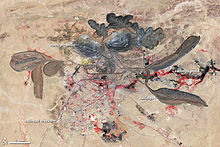Bayan obo mine
Coordinates: 41 ° 47 ′ 53.5 " N , 109 ° 58 ′ 31.4" E
The Bayan Obo Mine is a mine in the Inner Mongolia Autonomous Region of the People's Republic of China . It is the most important find and extraction site in the world for rare earth metals (SEE, English rare-earth-elements, REE). Up to 6000 people work in the opencast mine at a depth of no more than 1000 m.
geography
The Bayan Obo mine is located in the municipality Bayan Obo the prefecture-level city of Baotou , about 50 km south of the border with Mongolia and north of the prefecture-level city Bayan Nur .
history
Iron ore metals were discovered there as early as 1927 and rare earth metals in 1936. In the 1950s, a non-coated bearing was also found.
Deposit
Together with two others it is one of the world's most important deposits in China and together extract around 95% of the annual SEE. In 2005, this mine accounted for 45% of global SEE production. The ore deposit has a size of 40 million t with an ore content of 3 to 5.4% of the rare earth metals. Geologists suspect up to 35 million t of rare earths in the rock layers (this corresponds to almost 270 times the amount extracted in 2011). In the open pit elements are lanthanoids promoted: cerium , praseodymium , neodymium , lanthanum , yttrium , samarium , europium , gadolinium and erbium . The most important minerals extracted are bastnasite and monazite . With 470 million tons of iron, the mine is also one of the largest iron ore deposits in China. In addition, the Bayan Obo Mine is the largest non-coating deposit in the world.
environment
Price dumping due to low personnel and production costs in the mining and processing of rare earths made China an unrivaled monopoly in SEE exports at the beginning of the 21st century . The resulting lack of environmental protection requirements have led to serious environmental problems in and around Bayan Obo and elsewhere.
Individual evidence
- ↑ Bayan Obo deposit (Bayun-Obo deposit; Baiyunebo deposit), Bayan Obo, Bayan Obo mining district, Baotou League (Baotou Prefecture), Inner Mongolia Autonomous Region, China. In: mindat.org. July 4, 2018, accessed November 4, 2018.
- ↑ Alexander Jung, Wieland Wagner: Rare Earths. High-Tech Companies Face Shortages as China Hoards Metals. In: Spiegel Online . November 5, 2009, accessed November 4, 2018.
- ↑ Gerd Braune: "Rare Earths". Sought-after special metals. In: Handelsblatt Online. August 12, 2008. Retrieved November 4, 2018.
- ↑ a b Dieter Lohmann, Nadja Podbregar: In focus: Natural resources. Looking for raw materials. Springer, Berlin / Heidelberg 2012, ISBN 978-3-642-22610-6 , p. 9, doi: 10.1007 / 978-3-642-22611-3_2 .
- ↑ Wang Guozhen: Current Mining Situation and Potential Development of Rare Earth in China, China Nonferrous Engineering and Research Institute. In: Journal of Sichuan Rare earth. No 3, 2009.
- ↑ Jörg Neßler: Giant Bayan Obo REE-Fe-Nb Ore Deposit of Inner Mongolia, China. (No longer available online.) In: geoberg.de. Lutz Geißler, March 21, 2007, archived from the original on October 5, 2007 ; accessed on November 4, 2018 .

